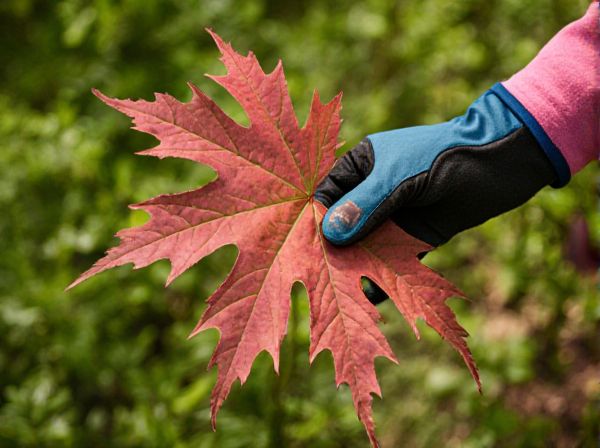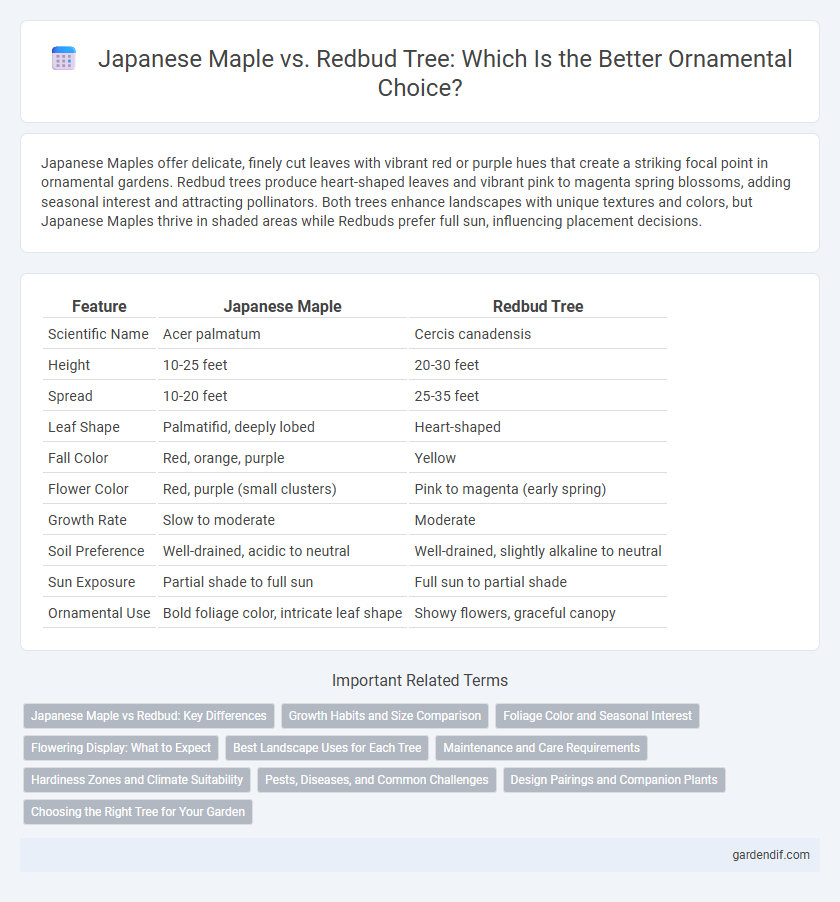
Japanese Maple vs Redbud Tree Illustration
Japanese Maples offer delicate, finely cut leaves with vibrant red or purple hues that create a striking focal point in ornamental gardens. Redbud trees produce heart-shaped leaves and vibrant pink to magenta spring blossoms, adding seasonal interest and attracting pollinators. Both trees enhance landscapes with unique textures and colors, but Japanese Maples thrive in shaded areas while Redbuds prefer full sun, influencing placement decisions.
Table of Comparison
| Feature | Japanese Maple | Redbud Tree |
|---|---|---|
| Scientific Name | Acer palmatum | Cercis canadensis |
| Height | 10-25 feet | 20-30 feet |
| Spread | 10-20 feet | 25-35 feet |
| Leaf Shape | Palmatifid, deeply lobed | Heart-shaped |
| Fall Color | Red, orange, purple | Yellow |
| Flower Color | Red, purple (small clusters) | Pink to magenta (early spring) |
| Growth Rate | Slow to moderate | Moderate |
| Soil Preference | Well-drained, acidic to neutral | Well-drained, slightly alkaline to neutral |
| Sun Exposure | Partial shade to full sun | Full sun to partial shade |
| Ornamental Use | Bold foliage color, intricate leaf shape | Showy flowers, graceful canopy |
Japanese Maple vs Redbud: Key Differences
Japanese Maples (Acer palmatum) feature finely dissected, vibrant foliage with a slow growth rate, making them ideal for small ornamental landscapes. Redbud trees (Cercis canadensis) showcase broad, heart-shaped leaves and striking pink spring blossoms, growing faster and reaching larger sizes. Key differences include leaf shape, growth speed, and seasonal flowering patterns, highlighting Japanese Maple's aesthetic delicacy versus Redbud's bold seasonal impact.
Growth Habits and Size Comparison
Japanese Maple (Acer palmatum) typically grows slowly, reaching heights of 15 to 25 feet with a spread of 15 to 20 feet, featuring a compact, rounded canopy ideal for small gardens and ornamental use. In contrast, the Redbud Tree (Cercis canadensis) grows more rapidly, attaining heights of 20 to 30 feet with a similar or wider spread, characterized by an open, spreading crown that provides a more expansive landscape presence. Both trees serve as stunning ornamental options, but the Japanese Maple's slower growth and smaller size suit limited spaces, whereas the Redbud thrives as a mid-sized shade tree with vibrant spring blossoms.
Foliage Color and Seasonal Interest
Japanese Maple showcases vibrant red to deep burgundy leaves that intensify in autumn, creating a striking seasonal display ideal for ornamental gardens. Redbud Tree offers heart-shaped leaves that emerge bright green in spring, turning golden or purplish in fall, adding multi-seasonal interest with its unique foliage transitions. Both trees provide excellent color contrast, but Japanese Maple is prized for its consistently rich red hues while Redbud emphasizes seasonal variation with its dynamic foliage palette.
Flowering Display: What to Expect
Japanese Maple trees exhibit delicate red or purple foliage with inconspicuous flowers, emphasizing foliage over floral display, while Redbud trees showcase vibrant pink to purple pea-like flowers that bloom profusely in early spring, creating a striking visual impact. The flowering display of Redbud trees tends to attract pollinators and offers seasonal color contrast against their heart-shaped leaves, unlike Japanese Maples which are primarily grown for their leaf texture and color. Gardeners seeking a showy spring floral display often prefer Redbuds, whereas Japanese Maples are favored for year-round ornamental foliage and form.
Best Landscape Uses for Each Tree
Japanese Maple thrives in shaded garden corners and small urban landscapes, offering intricate foliage and vibrant autumn color that create delicate focal points. Redbud Tree excels in larger spaces such as parks and residential yards, providing early spring blossoms and a broad canopy that enhances naturalistic or mixed border plantings. Both trees serve as versatile ornamental choices, with Japanese Maple emphasizing detailed, intimate settings and Redbud adding seasonal interest and structure to expansive landscapes.
Maintenance and Care Requirements
Japanese Maple requires consistent watering, well-drained soil, and protection from harsh afternoon sun to prevent leaf scorch, with moderate pruning to maintain shape and health. Redbud Trees are more drought-tolerant, thrive in a range of soils, and typically need less frequent pruning, mainly to remove dead or crossing branches. Both ornamental trees benefit from mulching to conserve moisture and reduce weed growth, but Japanese Maple demands more attentive care to avoid pest and disease issues.
Hardiness Zones and Climate Suitability
Japanese Maple (Acer palmatum) thrives in USDA Hardiness Zones 5-8, favoring temperate climates with partial shade and well-drained, acidic soil. Redbud Tree (Cercis canadensis) is more adaptable across Hardiness Zones 4-9, tolerating a wider range of climates including full sun and varied soil types. Gardeners in cooler regions benefit from selecting Redbud for its climate resilience, while Japanese Maple excels in moderate, sheltered environments.
Pests, Diseases, and Common Challenges
Japanese Maple trees often face challenges from aphids, scale insects, and verticillium wilt, which cause leaf discoloration and branch dieback. Redbud trees are susceptible to canker diseases, leaf gall, and verticillium wilt, with leaf blight posing a significant threat during wet conditions. Both species require vigilant monitoring and timely treatment to prevent pest infestations and fungal infections that compromise ornamental value.
Design Pairings and Companion Plants
Japanese Maple and Redbud trees offer striking contrast in ornamental design pairings, with Japanese Maples showcasing delicate, finely cut leaves in vibrant reds and purples, while Redbud trees display bold, heart-shaped leaves and vivid pink blossoms. Ideal companion plants for Japanese Maples include hostas and ferns that thrive in shady conditions, enhancing their delicate foliage, whereas Redbuds pair well with spring-flowering bulbs such as daffodils and tulips that complement their early blooms. Both trees benefit from underplanting with shade-tolerant groundcovers like ajuga or epimedium to create layered, dynamic landscape compositions.
Choosing the Right Tree for Your Garden
Japanese Maple offers delicate, lace-like leaves and vibrant red foliage ideal for small, shaded gardens, while Redbud Trees provide heart-shaped leaves and striking pink blossoms suited for larger, sunnier spaces. Consider soil type and climate adaptability, as Japanese Maple thrives in well-drained, acidic soils and partial shade, whereas Redbud tolerates various soils and full sun to partial shade. Selecting between these ornamental trees depends on your garden's size, light availability, and desired seasonal color impact.
Japanese Maple vs Redbud Tree Infographic

 gardendif.com
gardendif.com